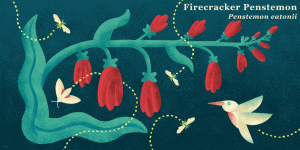
Artwork by Missy Ames
Craft Lake City is pleased to announce its newestseasonal public art exhibition, Celebration of the Hand: Planting For Pollinators. On view from March – April 2023, this exhibition endeavors to enliven the urban landscape of downtown Salt Lake City with artistic renderings of a vibrant, vivacious spring garden while inspiring the public to learn more about the importance of pollination. Craft Lake City invited 14 Utah-based visual artists to each create a piece of large-format digital artwork inspired by a specific species of pollinator-friendly flora for this project.
With scientific consultation from Red Butte Garden, each artist was provided with information about the key pollinators that interact with their chosen plant, including various types of bees, moths and hummingbirds, so that the artists could include them in joyous interaction with their flowering species of choice.
Celebration of the Hand: Planting For Pollinators aims to inspire Utahns to pay special consideration to pollinators while planning their spring garden, while also encouraging more people to cultivate a garden utilizing the space accessible to them.
Whether Utahns have access to a backyard, a community garden plot, or even a small container garden on a balcony or windowsill, anyone can grow beautiful plants that directly benefit the local pollinating ecosystem. Passers-by of this outdoor exhibition can scan a QR code on each of the 14 artworks to learn more about the featured pollinator-attracting species & how to cultivate each of the 14 featured Utah climate-friendly plants.
“Craft Lake City is proud to be spotlighting the beauty & importance of the pollination cycle in the heart of industrial downtown Salt Lake City,” says Liz Vowles, Artisan & Programs Manager for Craft Lake City. “As part of our organization’s mission to elevate the creative culture of the Utah arts community through science, technology, & art, we are energized to be presenting a major STEM cross-over in this high-visibility public art project!”
Celebration of the Hand, made possible with support from The Center for the Living City and The Temporary Museum of Permanent Change, is a seasonal outdoor exhibition designed to enhance and reflect Salt Lake City’s cultural district through the work of Utah artists. Informed by activist Jane Jacobs’ fascination with self-organized urbanism, Celebration of the Hand exhibitions focus on conveying central themes and ideas, making them relevant to our community through art.
Craft Lake City commissions works of art from local Utah artists for these rotating exhibitions. All Celebration of the Hand curation projects are displayed in fourteen metal frames adjacent to the sidewalks in downtown Salt Lake City. They are located on the north and south sides of Broadway (300 South) between 200 West and Main Street. These exhibitions are open to the public 24 hours a day 7 days a week, and are free of charge.
The public is invited to join Craft Lake City for a Lunch & Learn event on Tue., January 17 at noon MST. Attendees will have the opportunity to share ideas and ask questions about the new exhibition in downtown Salt Lake City, while learning about the artists highlighted by the project & the science behind pollination as presented by speakers from Red Butte Garden.
For more information about native plants & their pollinators, visit https://www.redbuttegarden.org/conservation-research/. For information about different kinds of native bees found at Red Butte Garden, visit https://redbuttegarden.org/plan-your-garden-visit/online-classes-virtual-resources/garden-journal/pollinator-week-native-bees-in-the-garden/.
Watch the Virtual Discussion About the Exhibition Below:

Learn About the Featured Pollinator-Attracting Plants & Preview the Artwork Below
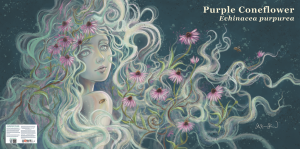
Purple Coneflower (Echinacea purpurea)
This popular garden perennial, with its showy purple flowers, grows well in dryer soils with full sun exposure. The flowers bloom from June to August and are visited by many pollinators including hummingbirds, bees, and butterflies. At the end of the growing season, you can remove dead flowers from stems but leaving some seed heads can provide a good food source for birds in the winter and allow self-seeding for new plants to grow. The genius Echinacea, comes from a Greek word meaning hedgehog, references the spiny center of the flowers. This echinacea species has and is still used medicinally to treat colds and flu like symptoms, among other illnesses.
About the Artist: McKenna Powell’s artwork include symbiotic figures and plants, and often convey symbolic elements about death, regrowth, and the changing landscape. She holds a love for nature, and believes society should coexist, and not be above it.
Instagram: @artistmckennapowell / Facebook: @artistmckennapowell / TikTok: @artistmckennapowell / linktr.ee/artistmckennapowell

Cosmos (Cosmos bipinnatus)
This showy annual is a Mexican and southern United States native with a long history of cultivation. Mexican priests appreciated the flower’s evenly placed and orderly petals, so they named it cosmos, conferring it as symbol for balance and harmony. Indeed, this flower adds balance to many gardens today as an attractive border or backdrop plant. Cosmos thrive in poor, well-drained, neutral to slightly alkaline soils. It prefers full sun and is fairly drought tolerant. Flowers bloom late in the season, persisting from June to first frost, and attract butterflies, birds, and bees. It seeds abundantly and sprouts readily in the right conditions, so many gardeners clip fruited stalks to control the plant’s spread and collect seeds for the following season.
About The Artist: My name is Lila. Ever since I was a little girl, I have always loved to draw. Art has forever been a medium for me to express myself and my love for what surrounds me. My goal is to create beautiful, whimsical depictions of my favorite aspects of this life and this planet. My art is made to inspire others and bring a light and playfulness wherever it goes.
www.lilavati.art / Instagram: @lilavati.art
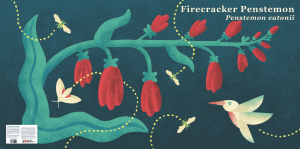
Firecracker Penstemon (Penstemon eatonii)
This showy perennial can be found throughout subalpine regions of the American West on dry, sandy soils and within disturbed sites. Its drought-tolerant tendencies and preference for poor soils also make it an easy addition to any water-wise garden – so long as itgets ample sunlight. This penstemon can be propagated from cutting, division, or seed, though seedlings typically need two years to flower. When bloom does come around in late spring to mid-summer, their striking red bloom entices hummingbirds as well as bees, wasps, and hawkmoths. To prolong the flowering period and prevent unwanted self-seeding, many gardeners opt to deadhead flowers. Though root rot is possible if overwatered, firecracker penstemon generally avoids common plant ailments and infection. Perhaps fittingly, this disease tolerant plant was also by indigenous peoples to treat almost anything from snake and spider bites to upset stomachs and burns.
About the Artist: Missy Ames is an artist and designer living in the Rocky Mountains. Her work follows the themes of travel and nature and she loves to experiment with painting methods and technology to capture different styles.
www.missyames.net / Instagram: @missyames
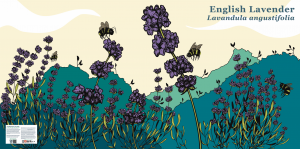
English Lavender (Lavandula angustifolia)
Called English lavender, this perennial actually hails from the Mediterranean region. Its name reportedly came from the plant’s ability to grow well in the English climate, though it has since become popular in temperate zones across the globe. It’s planted commercially for harvesting its fragrant oils for use in perfumes. Its flowers and foliage can also be used as culinary herbs. This lavender grows best in well-drained, medium to low fertility soils with full sun. Once established, it requires little water.Its small purple flowers are primarily pollinated by bumblebees, honey bees, and butterflies.
About the Artist: Bea Colón is a nonbinary, Latinx digital artist based out of Utah county. Their work is centered around character illustration, pop culture, and the reimagining of classic art through aqueer perspective.
Instagram: @tlc.artist
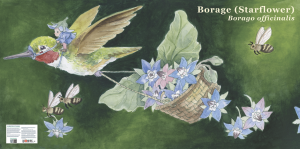
Borage (Borago officinalis)
This adaptable annual thrives in well-draining soils and full sun but can tolerate all types of soils and light shade. The edible flowers and leaves make it a great source of food for wildlife from summer to fall. The bright blue, star shaped flowers are attractive to pollinators like honeybees, bumble bees, and many native bee species. Its pleasant tasting flowers and leaves are used in culinary dishes including salads, sandwiches, and teas. The leaves are best eaten chopped up as the bristly hairs can have an undesirable texture. Borage is easily grown from seed and can successfully self-seed allowing it to grow back year after year. Although it is edible, consuming large amounts regularly can cause liver damage.
About the Artist: Kimberli was raised in the Salt Lake Valley, She loves exploring the mountains finding new flowers and plants, and is very inspired by folklore and fairy tales. Instagram: @kimberlistudio / Twitter: @kimberlistudio / TikTok: @kimberlistudio
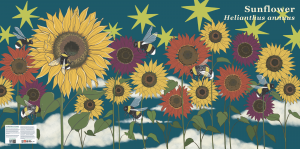
Sunflower (Helianthus annuus)
This iconic annual has dotted American prairies for thousands of years. For much of this time, Native Americans, who cultivated the plant for its edible seeds, have contributed to its spread. Fortunately, sunflower spreads easily, as it can tolerate a wide range of climates and soil conditions so long as it gets a little water and plenty of sun. Though still grown for its seeds today, this plant is just as popular for its enormous composite flower. Extensive crossing and hybridization allow modern gardeners to choose between a variety of flower colors and head shapes. Once the desired variety has been selected, seeds can be sown in late spring in moist, medium fertility soils. Watering regularly will improve growth, but sunflowers can tolerate mild droughts. However, these plants are susceptible to fungal spots and powdery mildew. Spacing stalks to allow ample airflow will mitigate risk of infection. Flowers typically bloom mid summer into early autumn, attracting bees of all sorts.
About the Artist: Victoria Minji Lee (she,her) is a Korean American multimedia artist. She is a tattooer and the owner ofEverybody Tattoo Studio in SLC, UT. Working mostly with ink, watercolor, and digital media, she finds joy in drawing and painting animals, plants, insects, and portraits. She often brings these themes together to create fun and whimsical compositions.
minjiyang.com / Instagram: @minjiyang_tattoer

Blue Flax (Linum perenne)
This herbaceous perennial can be found throughout most of North America, although it is native to Europe. Although short lived, its striking blue flowers bloom in early summer from May to June. The ability to grow in full sun, dry soils or rocks make it a great candidate for a drought resistant garden. It is easily grown from seed and can be cut back halfway through the growing season to prolong flowering. Blue flax is visited by smaller pollinators such as bees, flies, and butterflies. Its strong fibrous stems have been used to make rope and linen in parts of Europe.
About the Artist: Originally from the Midwest, Jennilyn Keinsley is a graphic designer and illustrator living in Ogden. After moving to Utah and falling in love with the mountains, she discovered that it was possible to explore the local scenery through her art. Jennilyn is currently working on a collection of decorative hiking trail maps that highlight popular trails along the Wasatch Front.
Instagram: @gohikeutah.art / @jennilyn.keinsley / etsy.com/shop/gohikeutah / jennilynkeinsley.com
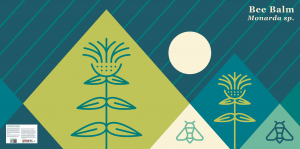
Bee Balm (Monarda spp.)
Bee balms are a collection of North American perennials from the Monarda genus. These poofy balls of color have become popular additions to pollinator gardens, as they attract a variety of pleasant visitors including bees, hummingbirds, and butterflies. Care for these flowers is largely dependent on the variety, as some species grow best in very different climates and soil conditions. The most popular garden varieties tend to grow best in rich, humusy, moisture-retentive soils, but some mountain varieties (M. odoratissima) do better in dry, rocky-sandy, well draining soil. Nearly all bee balms prefer full sun and can tolerate partial shade. Because many bee balms prefer moist soils and grow densely, powdery mildew can be a problem. Planting flowers with air circulation in mind often mitigates this issue. Though most gardeners select bee balms for their flowers, many are pleasantly surprised by the minty aroma released by the leaves of this mint family plant.
About the Artist: Fell is a husband & wife design studio that creates unique product to connect people with nature.
Instagram: @madebyfell
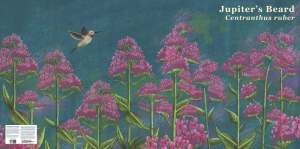
Jupiter’s Beard (Centranthus ruber)
This full sun perennial is easily grown in sandy, well drained soils. Its fragrant, star-shaped, pink flowers bloom from spring to fall, bringing lasting color to any garden or yard. With one of the longest blooming seasons, it is an important plant for many pollinators including bees, butterflies, and hummingbirds. If not deadheaded, Jupiter’s Beard can become weedy as it is very successful at self-seeding. Removing spent flower stems during the growing season can encourage additional blooms and help reduce to self-seeding.
About the Artist: Denise Plant is an illustrator residing with her family in Orem, Utah. She is inspired by Mid-Century Modern art, a lover of colors and bold patterns, and an avid dog enthusiast. In recent years you can find her booth at many maker’s markets in Utah where she sells stationery adorned with her illustrations along with kitschy craft creations reminiscent of yesterday.
Instagram: @denise_plant / deniseplant.com
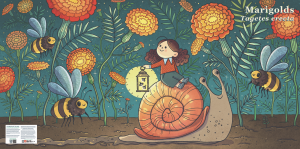
Marigold (Tagetes erecta)
This annual is a Mexican and Central American native that also grows well in the southwestern US. If growing from seeds, starting them indoors is often more successful. Young plants with healthy roots can be transplanted outdoors in mid-late spring once night time temperatures have warmed. These marigolds grow best in average, evenly moist, well-drained soils, though they can tolerate heavier clay soils as well. They typically grow in full sunlight, though they appreciate afternoon shade in hot climates. Its genus, Tagetes, is named for an Etruscan deity, Tages, and the specific epithet means erect or upright. This meaning is somewhat ironic as its stalks often need extra support to remain upright under the weight of their heavy flowerheads. Pinching back young plants promotes shorter, sturdier, and bushier growth. The showy flowers attract a diverse array of insect pollinators.
About the Artist: Ashley is a freelance illustrator who prefers to focus on the quirkier side of life. Her creations focus on bright colors & whimsical characters. She aims to evoke nostalgia in the viewer, reminding them of the child-like wonder & adventure we all miss as we grow up.
ashleyfairbourne.com / Instagram: @ashleyfairbourneillustration / Tiktok: @ashdrawsweird / Facebook: @ashleyfairbourneillustration

Orange Coneflower (Rudbeckia fulgida)
This hardy perennial thrives in well drained soils with full sun. Its vibrant orange flowers are very attractive to many pollinators including hummingbirds, bees, and butterflies. This echinacea can be easily propagated by division in the spring or fall and is low maintenance once established. Flowers bloom from early to late summer and can be maintained in a garden bed or container. Perfect for smaller outdoor space such as balconies or porches.
About the Artist: Hi! I’m the artist, Autumn Jones. I am a professional commission artist, indie game nerd, and stuffed animal connoisseur. I am also obsessed with all things winged and watercolor, and love art featuring both!
Instagram: @autumnjonesart / autumnjonesart.com
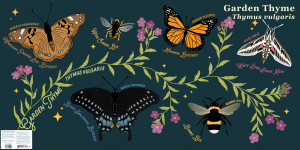
(Garden) Thyme (Thymus vulgaris)
This low maintenance herb is usually found cultivated in gardens for aromatic culinary purposes. However, it performs well in dry, sandy, or rocky soils making it a good choice for waterwise gardens, including rock gardens. It can grow up to 12inches in heights and can spread up to 16inches and should be trimmed to prevent it from getting too leggy. The small tubular flowers bloom in early summer and attract many species of bees and butterflies. The best way to cultivate is by stem cuttings or purchasing a plant from a local nursery, growing from seed can be difficult.
About the Artist: As a lifelong artist, Lauren started her brand The Doodling Nomad in 2017, while working in Alaska. From mountain peaks, to flowers and even the unknown, she hopes to highlight all things wild and weird and inspire others to stay wild.
Instagram: @thedoodlingnomad / www.thedoodlingnomad.com
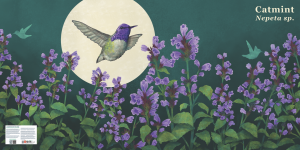
Catmint (Nepeta species)
This fragrant perennial can be found in dry, sunny areas making it a great waterwise addition to any garden or yard. This mint can be grown from seed or purchased from a nursery. Once established, catmint is long lived and easy to care for, growing well in a variety of soil types. The flowers are showy with beautiful shades of blue and purple that bloom from late spring into early fall. Catmint provides a great nectar source for pollinators, especially honeybees and hummingbirds. Its fragrance naturally deters predators such as rabbits and deer and smaller pests such as aphids.
About the Artist: Kylie Amber, b. 1997, is from Orem, Utah, where she currently is based. Her subject matter consists of elements from nature to explore the energy of the earth and how it can help connect us to things we can’t understand.
Instagram: @amberpaintings / www.kylieamber.com
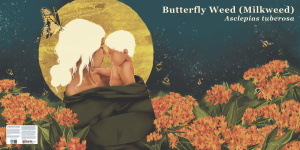
Butterfly Weed (Milkweed) (Asclepias tuberosa)
Butterfly weed is a showy perennial often planted to attract – you guessed it – butterflies. A member of the milkweed family, this species is somewhat uniquely devoid of milky-sapped stems. Butterfly weed also goes by pleurisy root in reference to a prior medicinal use of the plant roots to treat lung inflammations. It’s native to the Eastern and Southern United States, though it grows well out west, as well. It grows best in poor, well-draining soils with full sun. Once established, only occasional watering is necessary as butterfly weed can tolerate mild droughts. It seeds easily, but often takes 2 to 3 years to flower. When it does bloom, butterflies and bees abound.
About the Artist: Mallory Thurgood has been an artist for as long as she can remember. She began her art career as a watercolor painter, but more recently has discovered the joy of digital painting. After becoming a mother, Mallory found it hard to find the time and space to paint. Before her brother passed away at 23 years old in 2020 after a long battle with cancer, he encouraged her to try digital painting. Since discovering digital painting, Mallory has learned to process and express her grief and explore motherhood through her work. Her mother-baby series has helped her to move through postpartum depression, and she hopes to inspire others in their journeys as parents.
The painting “A Mother’s Milk” explores the relationship between a common type of milkweed, the Butterfly Weed, and the Swallowtail Butterfly. A mother’s milk is a newborn baby’s only food source; similarly, the Butterfly Weed is the sole source of nourishment for the Swallowtail Butterfly. Each connection is natural and divine.
Instagram: @mallorythurgoodart / etsy.com/shop/MalloryThurgoodArt

About Red Butte Garden:
Red Butte Garden is one of the largest botanical gardens in the Intermountain West and together with the University of Utah, is the State Arboretum of Utah. We are located on 100 acres in the foothills on the eastern edge of the University of Utah campus. The Garden has welcomed guests since 1985 and consists of over 21 acres of developed gardens and five miles of hiking trails winding through an extensive Natural Area. The Garden; which is community-funded; is renowned for its numerous plant collections, display gardens, 524,000 springtime blooming bulbs; including a vast collection of daffodils; gorgeous private event spaces, a world-class outdoor concert series, and award-winning horticulture-based educational programs.
About Craft Lake City:
Founded in 2009 by Angela H. Brown, Executive Editor of SLUG (Salt Lake UnderGround) Magazine, Craft Lake City® is a 501(c)(3) charitable organization with the mission to educate, promote and inspire local artisans while elevating the creative culture of the Utah arts community through science, technology and art. Craft Lake City strives to further define the term “Craft,” by modernizing the definition for handmade creativity.
craftlakecity.com @craftlakecity
Craft Lake City’s year-round programming is supported in part by the residents of Salt Lake County through the Zoo, Arts & Parks (ZAP) Program, the Salt Lake Arts Council, the George S. and Dolores Doré Eccles Foundation, and Utah Arts & Museums, with funding from the State of Utah and the National Endowment for the Arts.
About the Temporary Museum of Permanent Change:
The Temporary Museum of Permanent Change is a community based, participatory project that uses the ever-changing development processes underway in Salt Lake City as catalysts to animate city life. The Museum engages a variety of audiences using a collaborative, multidisciplinary approach that includes performance art and video production, visual art, urban archaeology, anthropology, local history, existing businesses and ongoing deconstruction and construction processes as spectacles for people of all ages. Together these elements provide teachable moments in our efforts to manage and celebrate change. This museum has no specific address. Rather it is a construction of ideas, installations and illuminations that comprise a new way of seeing our city.
About the Center for Living City:
The Center for the Living City’s purpose is to expand the understanding of the complexity of contemporary urban life and through it, promote increased civic engagement among people who care deeply for their communities. The Center provides portals for community engagement through the lens of urban ecology to further the understanding of the interconnected human and ecological systems in our communities. The Center’s multi-disciplinary approach to community engagement is applied through educational programs, collaborative projects, fellowships, on-line portals, workshops and publications.
centerforthelivingcity.org @centerforthelivingcity
